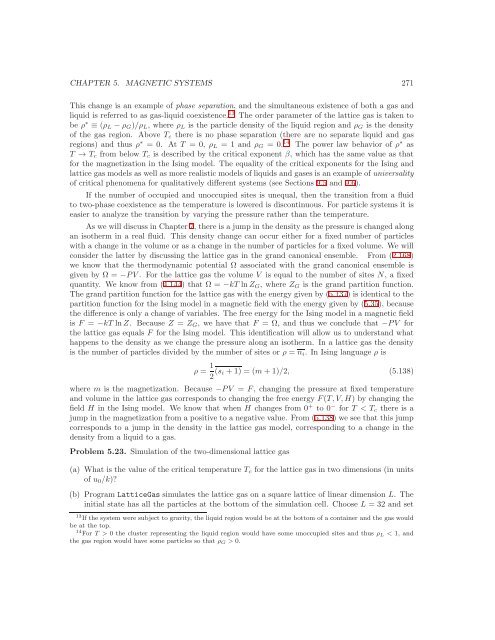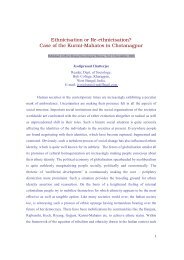Chapter 5 - WebRing
Chapter 5 - WebRing
Chapter 5 - WebRing
Create successful ePaper yourself
Turn your PDF publications into a flip-book with our unique Google optimized e-Paper software.
CHAPTER 5. MAGNETIC SYSTEMS 271<br />
This change is an example of phase separation, and the simultaneous existence of both a gas and<br />
liquid is referred to as gas-liquid coexistence. 13 The order parameter of the lattice gas is taken to<br />
be ρ ∗ ≡ (ρL −ρG)/ρL, where ρL is the particle density of the liquid region and ρG is the density<br />
of the gas region. Above Tc there is no phase separation (there are no separate liquid and gas<br />
regions) and thus ρ ∗ = 0. At T = 0, ρL = 1 and ρG = 0. 14 The power law behavior of ρ ∗ as<br />
T → Tc from below Tc is described by the critical exponent β, which has the same value as that<br />
for the magnetization in the Ising model. The equality of the critical exponents for the Ising and<br />
lattice gas models as well as more realistic models of liquids and gases is an example of universality<br />
of critical phenomena for qualitatively different systems (see Sections 9.5 and 9.6).<br />
If the number of occupied and unoccupied sites is unequal, then the transition from a fluid<br />
to two-phase coexistence as the temperature is lowered is discontinuous. For particle systems it is<br />
easier to analyze the transition by varying the pressure rather than the temperature.<br />
As we will discuss in <strong>Chapter</strong> 7, there is a jump in the density as the pressure is changed along<br />
an isotherm in a real fluid. This density change can occur either for a fixed number of particles<br />
with a change in the volume or as a change in the number of particles for a fixed volume. We will<br />
consider the latter by discussing the lattice gas in the grand canonical ensemble. From (2.168)<br />
we know that the thermodynamic potential Ω associated with the grand canonical ensemble is<br />
given by Ω = −PV. For the lattice gas the volume V is equal to the number of sites N, a fixed<br />
quantity. We know from (4.144) that Ω = −kT lnZG, where ZG is the grand partition function.<br />
The grand partition function for the lattice gas with the energy given by (5.137) is identical to the<br />
partition function for the Ising model in a magnetic field with the energy given by (5.35), because<br />
the difference is only a change of variables. The free energy for the Ising model in a magnetic field<br />
is F = −kT lnZ. Because Z = ZG, we have that F = Ω, and thus we conclude that −PV for<br />
the lattice gas equals F for the Ising model. This identification will allow us to understand what<br />
happens to the density as we change the pressure along an isotherm. In a lattice gas the density<br />
is the number of particles divided by the number of sites or ρ = ni. In Ising language ρ is<br />
ρ = 1<br />
2 (si +1) = (m+1)/2, (5.138)<br />
where m is the magnetization. Because −PV = F, changing the pressure at fixed temperature<br />
and volume in the lattice gas corresponds to changing the free energy F(T,V,H) by changing the<br />
field H in the Ising model. We know that when H changes from 0 + to 0 − for T < Tc there is a<br />
jump in the magnetization from a positive to a negative value. From (5.138) we see that this jump<br />
corresponds to a jump in the density in the lattice gas model, corresponding to a change in the<br />
density from a liquid to a gas.<br />
Problem 5.23. Simulation of the two-dimensional lattice gas<br />
(a) What is the value of the critical temperature Tc for the lattice gas in two dimensions (in units<br />
of u0/k)?<br />
(b) Program LatticeGas simulates the lattice gas on a square lattice of linear dimension L. The<br />
initial state has all the particles at the bottom of the simulation cell. Choose L = 32 and set<br />
13If the system were subject to gravity, the liquid region would be at the bottom of a container and the gas would<br />
be at the top.<br />
14For T > 0 the cluster representing the liquid region would have some unoccupied sites and thus ρL < 1, and<br />
the gas region would have some particles so that ρG > 0.

















